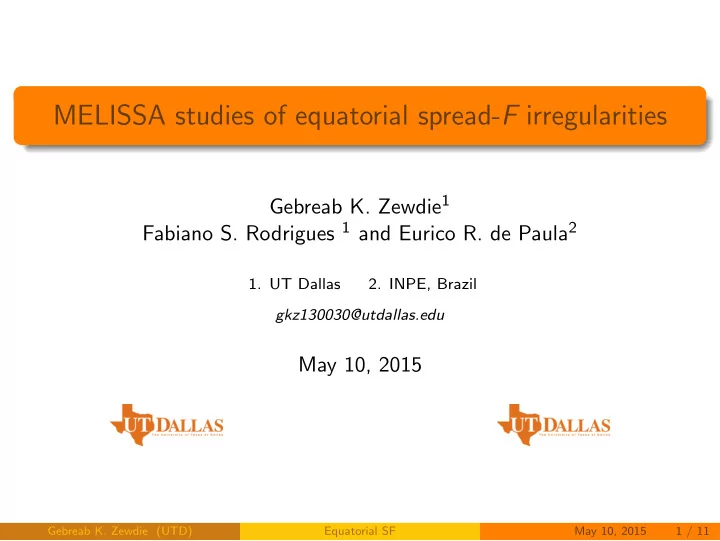

MELISSA studies of equatorial spread- F irregularities Gebreab K. Zewdie 1 Fabiano S. Rodrigues 1 and Eurico R. de Paula 2 1. UT Dallas 2. INPE, Brazil gkz130030@utdallas.edu May 10, 2015 Gebreab K. Zewdie (UTD) Equatorial SF May 10, 2015 1 / 11
Objectives Develop software tools for spectral analyses Apply the software tools to new measurements made by MELISSA Gebreab K. Zewdie (UTD) Equatorial SF May 10, 2015 2 / 11
Outline Introduction 1 Radar Observations 2 Estimated ESF Parameters 3 Summary 4 Gebreab K. Zewdie (UTD) Equatorial SF May 10, 2015 3 / 11
Equatorial Spread F Spread F irregularities are perturbations in the ionospheric electron density. They adversely affect radio propagations. Sources: Hysell et. al (2006), www.nasa.gov, www.cpi.com Gebreab K. Zewdie (UTD) Equatorial SF May 10, 2015 4 / 11
Radar Observations 80 60 40 SANYA 20 Bahir GADANKI Dar SAO 0 EAR LUIS JICAMARCA −20 −40 −60 −80 −150 −100 −50 0 50 100 150 Gebreab K. Zewdie (UTD) Equatorial SF May 10, 2015 5 / 11
MELISSA (Measurement of Equatorial and Low-latitude Ionospheric irregularities over Sao Luis, South America) Gebreab K. Zewdie (UTD) Equatorial SF May 10, 2015 6 / 11
Radar Parameters Summary of Radar parameters for the 2014 Observations Parameter Value Radar Frequency 30MHz Peak power 16kW Lowest height sampled 90km Highest height sampled 1222.8km Baud length 2.4km Number of FFT points 64 Number of FFT spectra averaged 25 Gebreab K. Zewdie (UTD) Equatorial SF May 10, 2015 7 / 11
Examples of Measurements 1000 10 800 0 600 -10 400 200 -20 19 19.5 20 20.5 21 21.5 22 22.5 23 23.5 24 19:45 LT 20:07 LT 20:45 LT 22:03 LT 397.2 km 637.2 km 447.6 km 397.2 km -200 0 200 -200 0 200 -200 0 200 -200 0 200 19:45 LT 20:07 LT 20:45 LT 22:03 LT 394.8 km 634.8 km 445.2 km 394.8 km -200 0 200 -200 0 200 -200 0 200 -200 0 200 19:45 LT 20:07 LT 20:45 LT 22:03 LT 392.4 km 632.4 km 442.8 km 392.4 km -200 0 200 -200 0 200 -200 0 200 -200 0 200 Doppler Vel. [m/s] Doppler Vel. [m/s] Doppler Vel. [m/s] Doppler Vel. [m/s] Observations made by the MELISSA radar on March 22, 2014. The top panel shows the RTI map. The bottom panels show examples of spectra estimated. Gebreab K. Zewdie (UTD) Equatorial SF May 10, 2015 8 / 11
Examples of Measurements 22−Mar−2014 − SNR [dB] 1000 15 10 800 5 Height [km] 0 600 −5 −10 400 −15 200 −20 19:00 20:00 21:00 22:00 23:00 Mean Doppler Velocity [m/s + Up] 1000 100 800 50 Height [km] 600 0 400 −50 200 −100 19:00 20:00 21:00 22:00 23:00 Spectral Witdh [m/s] 1000 100 80 800 Height [km] 60 600 40 400 20 200 0 19:00 20:00 21:00 22:00 23:00 Local Time Examples of parameters derived using the MELISSA radar on March 22, 2014. SNR (top panel), vertical velocity (middle panel) and spectral width (bottom) panel. Gebreab K. Zewdie (UTD) Equatorial SF May 10, 2015 9 / 11
Histograms 22-Mar-2014 - SNR > 0 dB 0.5 0.5 0.45 0.45 0.4 0.4 0.35 0.35 Occurrence Rate Occurrence Rate 0.3 0.3 0.25 0.25 0.2 0.2 0.15 0.15 0.1 0.1 0.05 0.05 0 0 -300 -200 -100 0 100 200 300 0 50 100 150 200 250 300 Mean Doppler Vel. [m/s, + Up] Spectral Width [m/s] Histograms of mean Doppler velocities (+ upward) and spectral widths estimated from the observations made by MELISSA on March 22, 2014. Gebreab K. Zewdie (UTD) Equatorial SF May 10, 2015 10 / 11
Summary and Conclusion We implemented tools that calculate spectral parameters: Doppler velocity, spectral width, and power Doppler velocities fall within ± 100m/s Spectral width values fall below 100m/s We have not yet observed supersonic velocities of Spread F irregularities commonly observed by Jicamarca [e.g. Hysell et al. (2004) ]. Gebreab K. Zewdie (UTD) Equatorial SF May 10, 2015 11 / 11
Recommend
More recommend